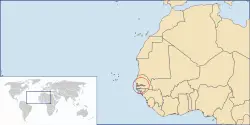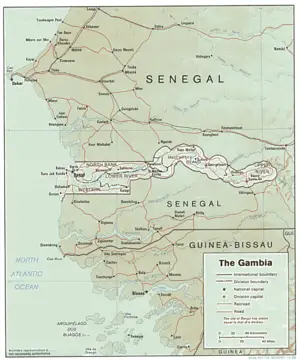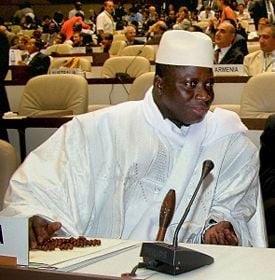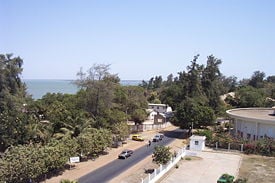The Gambia
| Republic of The Gambia | ||||||
|---|---|---|---|---|---|---|
|
||||||
| Motto: "Progress, Peace, Prosperity" | ||||||
| Anthem: For The Gambia Our Homeland |
||||||
| Capital | Banjul | |||||
| Largest city | Serekunda | |||||
| Official language(s) | English | |||||
| National languages | Mandinka, Wolof, Fula, Serer, Jola | |||||
| Demonym | Gambian | |||||
| Government | Presidential republic | |||||
| - | President | Yahya Jammeh | ||||
| - | Vice President | Isatou Njie-Saidy | ||||
| Independence | ||||||
| - | from the United Kingdom | 18 February 1965 | ||||
| - | Republic declared | 24 April 1970 | ||||
| Area | ||||||
| - | Total | 10,380 km2 (164th) 4,007 sq mi |
||||
| - | Water (%) | 11.5 | ||||
| Population | ||||||
| - | 2009 estimate | 1,705,000[1] (146th) | ||||
| - | Density | 164.2/km2 (74th) 425.5/sq mi |
||||
| GDP (PPP) | 2010 estimate | |||||
| - | Total | $3.494 billion[2] | ||||
| - | Per capita | $2,018[2] | ||||
| GDP (nominal) | 2010 estimate | |||||
| - | Total | $1.067 billion[2] | ||||
| - | Per capita | $616[2] | ||||
| Gini (1998) | 50.2 (high) | |||||
| HDI (2007) | ||||||
| Currency | Dalasi (GMD) |
|||||
| Time zone | GMT | |||||
| Drives on the | right | |||||
| Internet TLD | .gm | |||||
| Calling code | 220 | |||||
The Gambia, commonly known as Gambia, is the smallest country on the African continental mainland and is surrounded by Senegal, except for a small coast on the Atlantic Ocean in the west. The River Gambia flows through the center of the country and empties into the Atlantic.
Like its neighbor, The Gambia relies heavily on the export of groundnuts (peanuts) and on tourism for revenue (it is known as a birdwatcher's paradise). Though its population is small (1.5 million), its people belong to eight ethnic groups that live together harmoniously. In his 1977 Pulitzer Prize-winning book Roots: The Saga of an American Family, Alex Haley traced his family back to Kunta Kinte, enslaved from the village of Juffure on the north bank of The Gambia.
Geography
The Gambia is a very small and narrow country—about 20 miles wide. The country's present boundaries were defined in 1889 after an agreement between the United Kingdom and France. The Gambia River, one of the easiest rivers in Africa to navigate, would likely have beocme the principal artery of trade for Senegal, The Gambia, and landlocked Mali were it not for the European-imposed boundaries.
Apart from its coastline, where The Gambia borders the Atlantic Ocean, it is an enclave of Senegal and is slightly less than twice the size of the U.S. state of Delaware
The climate is tropical, with a hot, rainy season (June to November) and a cooler, dry season (November to May).
The terrain is a flood plain of the Gambia River. On each side of the river are mangrove trees. Past them are swamps, succeeded by hills and plateaus.The lowest point is at the Atlantic. Its highest point is an unnamed location (53 m).
Like Senegal, its major natural resources are fish and groundnuts (peanuts). Only 18 percent of the land is arable. Forests and woodland make up 28 percent of the land. Rainfall has dropped by 30 percent in the last thirty years.
Fauna and flora
More than 570 species of birds (both resident and [[migration|migratory) have been found in the small country. Among those found in the Abuko Nature Reserve are the largest and smallest kingfishers in the world. The BBC documentary Jewel in the Sun was shot there. Abuko is also part of the Chimpanzee Rehabilitation Program that prepares captured chimps for release back into the wild.
The Gambia River provides habitat for wildlife, including dolphins, crocodiles, and hippopotamus. Bush hogs, hyenas, monkeys, baboons, antelopes, foxes, squirrels, and other smaller animals are found in the Kiang West National Park,
History
The first written accounts of the region come from records of Arab traders in the ninth and tenth centuries C.E.. In 1066, the inhabitants of Tekrur, a kingdom centered on the Sénégal River just to the north, became the first people in the region to convert to Islam. Muslim traders established the trans-Saharan trade route for slaves, gold, and ivory. At the beginning of the fourteenth century, most of what is today called The Gambia was a tributary to the Mali Empire. The Portuguese reached the area by sea in the mid-fifteenth century and began to dominate the lucrative trade.
In 1588, the claimant to the Portuguese throne, António, Prior of Crato, sold exclusive trade rights on the Gambia River to English merchants; this grant was confirmed by letters patent from Queen Elizabeth I. In 1618, James I granted a charter to a British company for trade with Gambia and the Gold Coast (now Ghana).
During the late seventeenth century and throughout the eighteenth, Britain and France struggled continually for political and commercial supremacy in the regions of the Senegal and Gambia rivers. The 1783 Treaty of Versailles gave Great Britain possession of the Gambia River, but the French retained a tiny enclave at Albreda on its north bank, which was finally ceded to the United Kingdom in 1857.
Slave trade
As many as three million slaves may have been taken from the region during the three centuries that the transatlantic slave trade operated. It is not known how many slaves were taken by Arab traders prior to and simultaneous with the transatlantic slave trade. Most of those taken were sold to Europeans by other Africans; some were prisoners of intertribal wars; some were sold because of unpaid debts, while others were kidnapped. Slaves were initially sent to Europe to work as servants until the market for labor expanded in the West Indies and North America in the eighteenth century. In 1807, slave trading was abolished throughout the British Empire, and the British tried unsuccessfully to end the slave trade in The Gambia. Between 1780 and 1820, gum (used in the textile industry and obtained from acacia trees) overtook slaves in exports from the region.
The British established the military post of Bathurst (now Banjul) in 1816. In the ensuing years, Banjul was at times under the jurisdiction of the British Governor General in Sierra Leone. In 1888, The Gambia became a separate colonial entity.
An 1889 agreement with France established the present boundaries, and The Gambia became a British Crown Colony, divided for administrative purposes into the colony (city of Banjul and the surrounding area) and the protectorate (remainder of the territory). The Gambia received its own executive and legislative councils in 1901 and gradually progressed toward self-government. A 1906 ordinance abolished slavery.
During World War II, Gambian troops fought with the Allies in Burma. Banjul served as an air stop for the U.S. Army Air Corps and a port of call for Allied naval convoys. U.S. President Franklin D. Roosevelt stopped overnight in Banjul en route to and from the Casablanca Conference in 1943, marking the first visit to the African continent by an American president while in office.
Post-independence
After World War II, the pace of constitutional reform increased. Following general elections in 1962, full internal self-governance was granted the following year. The Gambia achieved independence on February 18, 1965, as a constitutional monarchy within the Commonwealth of Nations. Shortly thereafter, the government held a referendum proposing that an elected president replace the British monarch as head of state. The referendum failed to receive the two-thirds majority required to amend the constitution, but the results won widespread attention abroad as testimony to The Gambia's observance of secret balloting, honest elections, and civil rights and liberties. On April 24, 1970, The Gambia became a republic within the Commonwealth, following a second referendum, with Prime Minister Sir Dawda Kairaba Jawara as head of state.
Until a military coup in July 1994, The Gambia was led by Jawara, who was re-elected five times. The relative stability of the Jawara era was shattered first by a coup attempt in 1981. The coup was led by Kukoi Samba Sanyang, who, on two occasions, had unsuccessfully sought election to Parliament. After a week of violence that left several hundred people dead, Jawara, in London when the attack began, appealed to Senegal for help. Senegalese troops defeated the rebel force.
In the aftermath of the attempted coup, Senegal and The Gambia signed the 1982 Treaty of Confederation. The Senegambia Confederation came into existence; it aimed eventually to combine the armed forces of the two states and to unify their economies and currencies. The Gambia withdrew from the confederation in 1989.
In July 1994, the Armed Forces Provisional Ruling Council (AFPRC) seized power in a military coup d'état that deposed the Jawara government. Lieutenant Yahya Jammeh, chairman of the council, became head of state and has been tightening his hold on power ever since, harassing opposition political parties and critical media.
Politics
Before the 1994 coup d'état, The Gambia was one of the oldest existing multi-party democracies in Africa. It had conducted freely contested elections every five years since independence. After the coup, politicians from deposed President Jawara's People's Progressive Party (PPP) and other senior government officials were banned from participating in politics until July 2001.
In late 2001 and early 2002, The Gambia completed a full cycle of presidential, legislative, and local elections. President Jammeh was re-elected and his party, the Alliance for Patriotic Reorientation and Construction (APRC) maintained its strong majority in the National Assembly, particularly after the main opposition United Democratic Party (UDP) boycotted the legislative elections. Non-APRC candidtates won only 3 seats in the 53-member legislature.
Jammeh won the 2006 election handily after the opposition coalition, the National Alliance for Development and Democracy, had splintered earlier in the year. Jammeh had said, "I will develop the areas that vote for me, but if you don't vote for me, don't expect anything[3]."
In March 2006, amid tensions preceding the 2006 presidential elections, an alleged planned military coup was uncovered. Many suspected officers were arrested, and prominent army officials fled the country.
The 1970 constitution, which divided the government into independent executive, legislative, and judicial branches, was suspended after the 1994 military coup. As part of the transition process, the AFPRC established the Constitution Review Commission (CRC) through decree in 1995. The commission drafted a new constitution, which was approved by referendum in 1996. The constitution provides for a strong presidential government, a unicameral legislature, an independent judiciary, and the protection of human rights.
Media
Critics have accused the government of restricting free speech. A law passed in 2002 created a commission with the power to issue licenses and imprison journalists; in 2004, additional legislation allowed prison sentences for libel and slander and canceled all print and broadcasting licenses, forcing media groups to re-register at five times the original cost[4][5].
Three Gambian journalists have been arrested since the coup attempt. It has been suggested that they were imprisoned for criticizing the government's economic policy or for stating that a former interior minister and security chief was among the plotters.[6] Newspaper editor Deyda Hydera was shot to death under unexplained circumstances, days after the 2004 legislation took effect.
Licensing fees are high for newspapers and radio stations, and the only nationwide stations are tightly controlled by the government[7]
Reporters Without Borders has accused "President Yahya Jammeh’s police state" of using murder, arson, unlawful arrest, and death threats against journalists.[8][9]
In June 2007. Reporters Without Borders condemned the sentence of a year in prison or "optional" fine of $1,850 imposed on a reporter for getting facts wrong in a story for the now banned, privately owned biweekly The Independent.
"[The reporter] was already held illegally for two months in this case," the press freedom organization said. "His publisher and his editor were also held for several weeks in a completely illegal fashion. Pay up or be imprisoned, this is the threat that President Yahya Jammeh now wants to hold over his country's press."
Administrative divisions
The Gambia is divided into five divisions and one city. These are:
- Lower River
- Central River
- North Bank
- Upper River
- Western
(Banjul, the national capital, is classified as a "city.") The divisions are further subdivided into 37 districts.
Economy
The Gambia has a market-based economy characterized by traditional subsistence agriculture, a historic reliance on groundnuts (peanuts) for export earnings, a re-export trade built up around its ocean port, low import duties, minimal administrative procedures, and a fluctuating exchange rate with no exchange controls. The once-significant tourism industry has been hurt by the deteriorating conditions in the country. In addition, The Gambia has become known as a transit point for the drug trade.
Agriculture accounts for 29 percent of gross domestic product (GDP) and employs 75 percent of the labor force. Within agriculture, peanut production accounts for 85 percent of export earnings. About 60 percent of cultivated land is devoted to groundnuts.
Industry accounts for 12 percent of GDP. Manufacturing, which accounts for 5.5 percent of GDP, is primarily agriculturally based (e.g., peanut processing, bakeries, a brewery, and a tannery). Other manufacturing activities include soap, soft drinks, and clothing. Services account for 19 percent of GDP.
The UK and other EU countries constitute The Gambia's major domestic export markets, accounting for 86 percent in total; followed by Asia at 14 percent; and the African subregion, including Senegal, Guinea-Bissau, and Ghana at 8 percent. The UK and the other EU countries (Germany, France, Netherlands, Belgium) were the major source of imports, at 60 percent of the total share of imports, followed by Asia at 23 percent, and Cote d'Ivoire and other African countries at 17 percent. The Gambia reports 11 percent of its exports going to and 14.6 percent of its imports coming from the United States.
Demographics
A wide variety of ethnic groups live in The Gambia with a minimum of intertribal friction, each preserving its own language and traditions. The Mandinka tribe is the largest, followed by the Fula, Wolof, Jola, and Serahule. The approximately 3,500 non-African residents include Europeans and families of Lebanese origin (roughly 0.23 percent of the total population).
Muslims constitute more than 92 percent of the population. Christians of various denominations account for most of the remainder. Gambians officially observe the holidays of both religions and practice religious tolerance.
More than 80 percent of Gambians live in rural villages, although more and more young people come to the capital, Namjul, in search of work and education. While urban migration, development projects, and modernization are bringing more Gambians into contact with Western habits and values, the traditional emphasis on the extended family, as well as indigenous forms of dress and celebration, remain integral parts of everyday life.
Poverty is widespread, pervasive, and predominantly rural. Half of the people living in rural areas are poor. More than 90 percent of extremely poor people in the country and more than 70 percent of other poor people depend on agriculture for their livelihood. Every year poor people in rural areas face the so-called hungry season, a two- to four-month period at the peak of the rainy season between July and September when household food stocks are low. Poor households depend on income generated by groundnuts or other cash crops to cover the cost of school fees and medicines. Falling market prices mean that households have less money to meet basic needs.
The incidence of poverty is highest in rural groundnut-producing areas. Women have a higher incidence and severity of poverty than men. Traditionally they do not own or control land, but they bear a disproportionately heavy burden of labor. They lack access to credit for income-generating activities, and they generally have no voice in the decisions that affect their lives. The percentage of literate women over the age of 15 is half that of men.
Poverty in the Gambia has its roots in slow economic growth and uneven income distribution. Rural poverty, in particular, is the result of a poor natural resource base and farmers' dependence on groundnuts as their principal source of income.
The primary causes of rural poverty in the Gambia are:
- low and decreasing soil fertility
- low agricultural and labor productivity
- poor access to productive assets such as land and water
- poorly functioning input and output markets
- low prices on world markets for products such as groundnuts and certain types of rice
- poorly functioning rural institutions, including credit institutions, and lack of basic social services
- irregular rains that frequently cause crop losses, and yields that fluctuate as much as 40 percent from one harvest to the next
Life expectancy at birth is 53.2 years.
The Gambia is a source, transit, and destination country for children and women trafficked for the purposes of forced begging and labor (boys) and for commercial sexual exploitation (girls and women) in European sex tourism.
Ethnic groups
The population is 99 percent African:
- Mandinka 42 percent
- Fula 18 percent
- Wolof 16 percent
- Jola 10 percent
- Serahuli 9 percent
- Other 4 percent
Languages
English is the official language, with Mandinka, Wolof, Fula, and other indigenous vernaculars also spoken. The overall literacy rate is 38.6 percent. For males it is 52.8 percent and for females 24.9 percent (1995 est.).
Tourism
The tourism industry in The Gambia started when a party of three hundred Swedish tourists arrived in 1965. It was seen as an ideal place to escape the harsh winter months of Scandinavia where Europeans could not only enjoy sun, sand and beaches but also experience the excitement of a real African holiday. Moreover, due to its proximity, it offered an affordable holiday. The government is eager to diversify the economy and recognized tourism as a potential major source of foreign exchange. However, infrastructure development has been slow. The activities available to tourists include river cruising, fishing, village tours, African wrestling, birdwatching, horse and camel riding, sports and musical events.
Culture
The Gambia has a variety of traditional musical instruments. The best known is the kora, a 21-string harp played by Mandingo peoples throughout West Africa. Crafts made by its people include antic masks, carvings, batik products, handwoven fabrics, leatherwork, and jewelry.
The staple foods are rice, millet, and maize.
Issues
The government is increasingly repressive, throttling all criticism. Environmental issues include deforestation and desertification. Water-borne diseases are prevalent. Poverty and low agricultural productivity are widespread.
Notes
- ↑ Department of Economic and Social Affairs Population Division (2009). World Population Prospects, Table A.1. Retrieved October 23, 2011.
- ↑ 2.0 2.1 2.2 2.3 Error on call to template:cite web: Parameters url and title must be specified. International Monetary Fund.
- ↑ Africa: Gambia: Leader Vows To Rule For Next 40 Years, New York Times Company, 2008. Retrieved March 6, 2008.
- ↑ Country profile: The Gambia, BBC, 2008. Retrieved March 6, 2008.
- ↑ President tightens media laws in The Gambia, Mail & Guardian, 2008
- ↑ Banjul newspaper reporter freed on bail pending trial Reporters Without Borders. Retrieved March 6, 2008.
- ↑ Country profile: The Gambia, BBC, 2008. Retrieved March 6, 2008.
- ↑ Gambia - Annual report 2005 Gambia - Annual report 2005, Reporters Without Borders. Retrieved March 6, 2008.
- ↑ Journalist freed after being held illegally for 139 days by intelligence agents, Reporters Without Borders. Retrieved March 6, 2008.
ReferencesISBN links support NWE through referral fees
- Cutter, Charles Hickman. 2006. Africa, 2006. World today series. Harpers Ferry, WV: Stryker-Post Publications. ISBN 1887985727 ISBN 9781887985727
- Gamble, David P. 1988. The Gambia. World bibliographical series, v. 91. Oxford, England: Clio Press. ISBN 1851090681 ISBN 9781851090686
- Iliffe, John. 1995. Africans: the history of a continent. African studies series, 85. Cambridge: Cambridge University Press. ISBN 9780521482356 ISBN 0521484227
- Zimmermann, Robert. 1994. The Gambia. Enchantment of the world. Chicago: Childrens Press. ISBN 0516026259 ISBN 9780516026251
External links
All links retrieved April 30, 2023.
- About The Gambia – Dansk.
- Country Profile - The Gambia – British Broadcasting Coorporation.
Credits
New World Encyclopedia writers and editors rewrote and completed the Wikipedia article in accordance with New World Encyclopedia standards. This article abides by terms of the Creative Commons CC-by-sa 3.0 License (CC-by-sa), which may be used and disseminated with proper attribution. Credit is due under the terms of this license that can reference both the New World Encyclopedia contributors and the selfless volunteer contributors of the Wikimedia Foundation. To cite this article click here for a list of acceptable citing formats.The history of earlier contributions by wikipedians is accessible to researchers here:
The history of this article since it was imported to New World Encyclopedia:
Note: Some restrictions may apply to use of individual images which are separately licensed.






